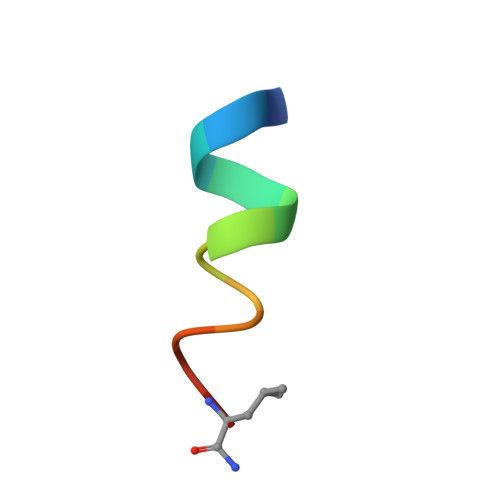Protonectin peptides target lipids, act at the interface and selectively kill metastatic breast cancer cells while preserving morphological integrity.
Batista Martins, D., Fadel, V., Oliveira, F.D., Gaspar, D., Alvares, D.S., Castanho, M.A.R.B., Dos Santos Cabrera, M.P.(2021) J Colloid Interface Sci 601: 517-530
- PubMed: 34090029
- DOI: https://doi.org/10.1016/j.jcis.2021.05.115
- Primary Citation of Related Structures:
6N68 - PubMed Abstract:
Despite the need for innovative compounds as antimicrobial and anticancer agents, natural sources of peptides remain underexplored. Protonectin (PTN), a cationic dodecapeptide of pharmacological interest, presents large hydrophobicity that is associated with the tendency to aggregate and supposedly influences bioactivity. A disaggregating role was assigned to PTN' N-terminal fragment (PTN 1-6 ), which enhances the bioactivity of PTN in a 1:1 mixture (PTN/PTN 1-6 ). Spectroscopic techniques and model membranes (phospholipid bilayers and SDS micelles) revealed that environment-dependent aggregation is reduced for PTN/PTN 1-6 , but cytotoxicity of PTNs on MDA-MB-231 breast cancer showed the same CC 50 values around 16 µM and on MCF-10A epithelial breast cells 6 to 5-fold higher values, revealing a selective interaction. Since PTN 1-6 lacks activity on breast cells, its presence should differently affect PTN activity, suggesting that aggregation could modulate activity depending on the membrane characteristics. Indeed, increased partitioning and lytic activity of PTN/PTN 1-6 were found in model membranes independently of charge density, but affected by the curvature tendency. PTN and PTN/PTN 1-6 do not alter morphology and roughness of cancer cells, indicating a superficial interaction with membranes and consistent with results obtained in NMR experiments. Our results indicate that aggregation of PTNs depends on the membrane characteristics and modulates the activity of the peptides.
Organizational Affiliation:
Departamento de Física, Universidade Estadual Paulista (UNESP), Instituto de Biociências Letras e Ciências Exatas (IBILCE), R. Cristóvão Colombo, 2265, 15054-000 São José do Rio Preto, SP, Brazil.














